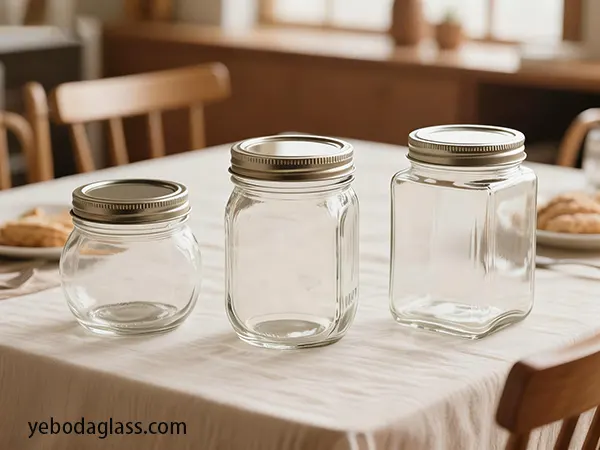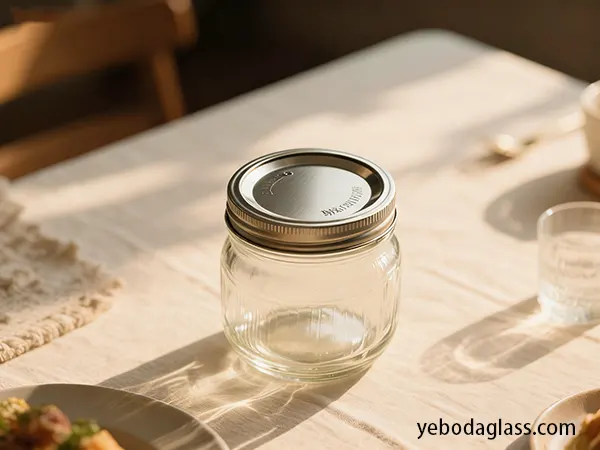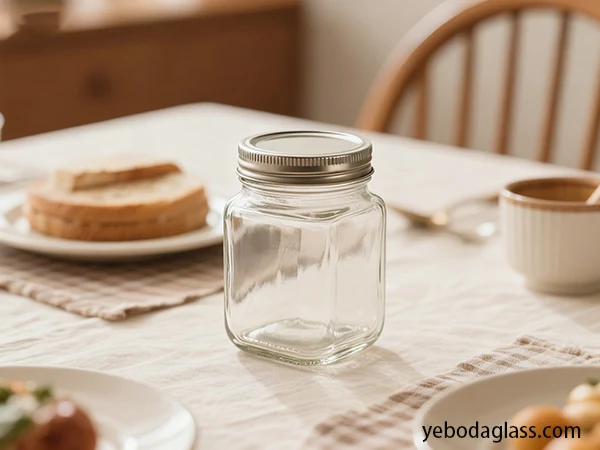Introduction
The conversion of ordinary mason jars into customized, market-ready items is based on a detailed strategic framework. This framework serves not only as a guide for the decisions to be made but also as a tool to anticipate the main factors of the cost, risks, and the feasibility of the production process. In the case of mason jars customize
, the initial strategic decisions have a determining influence on the later stages of the process – the engineering and design stages, as well as the supply chain alignment. Having a definite route laid out lessens the risk of errors and makes it possible to fulfill the set functional as well as the aesthetic objectives.

Production Scale (Volume)
The method of personalization to be used is mainly determined by the production volume, which has a direct bearing on the project’s tooling, machinery, and decorating technologies in the case of mason jars customize.
Low Volume: <5,000 Units (Boutique or Pilot Runs)
- Technologies: Digital printing, laser engraving, decal application
- Advantages: Infinite flexibility, no mold investment, fast iteration
- Applications: Wedding gifts, seasonal releases, artisan brands
This scale perfectly fits the mason jars customize project of small volume that requires high design flexibility.
Medium Volume: 5,000–50,000 Units (Regional Brands)
- Technologies: Screen printing, spray coating, semi-automated production
- Supply Chain: Stock jars are usually sourced from the open market, while decoration is done by outsourcing
The segment covered by this example is the greatest part of commercial mason jars projects, in which a proper balance between cost efficiency and customization depth is achieved.
High Volume: >50,000 Units (National/Global Distribution)
- Technologies: IS machine manufacturing, ceramic printing, automated coating lines
- Supply Chain: Fully-vendor partnerships, long-term forecasting
At this stage optimizing the cost per unit becomes very important. High-volume mason jars projects can greatly take advantage of the development of proprietary molds to ensure quality and lower costs in the long run.
Mason Jars Customize Complexity
Surface Decoration
Surface decoration changes only the outer part of mason jars while the structural geometry is kept intact. Most of the techniques used are:
- Advertising by printing on glass
- Digital printing
- Shrink sleeves
- Laser engraving
- Coatings (frosted, matte, gradients)
With surface decoration, virtually any design is possible, and at the same time, it is done with standard mold jars.
Structural Modification
Structural modification means that one has to create proprietary molds, the possibilities are:
- Embossed or debossed logos
- New shapes and contours
- Non-standard capacities
- Custom neck finishes
This channel is the one with the highest investment in mason jars customize and gives the brand a strong distinctive power.
End-Use Application
Food & Beverage
Highly demanding regulatory requirements: thermal shock resistance, FDA/EC food-contact compliance. Hermetic lid compatibility ensures product safety in hot-filling, and pasteurization processes
Cosmetics & Personal Care
Concentrating on chemical compatibility, aesthetic quality, and brand differentiation.
Decorative & General Storage
The most versatile of the three: it also allows non-food-grade coatings, unconventional finishing, and creative designs.

Yeboda Advantage in Mason Jars Customize
With a full-package service for mason jars customization, Yeboda is an integrated mold design, glass shaping, and in-house decoration supplier. This arrangement lessens the complication of having numerous vendors and quality can be maintained at all stages from mason jars production to the final market-ready product.
Material Science and Component Specification
The selection of materials and the accurate detailing of components are the factors that dominate the performance, safety, and the possibility of mason jars to appeal to the market. A thorough investigation at this point guarantees that your jars will not only be in line with the law but also impart a luxurious feeling which will be a source of brand power for you.
Glass Composition and Quality
Choosing a proper type of glass is very necessary. Soda-lime glass is a perfect material for mason jars as it is strong, clear, and quite easy to recycle. Whereas, high borosilicate glass is extremely resistant to heat, and therefore, it is the best choice for the jars that will be heated or for the storage that will be kept for a long time. By standardizing the glass thickness, bulk orders holes can be looked at not only from the side of the appearance but also the glass strength.
Closure Systems and Seal Integrity
The closure plays a vital role in the total concept of the jar. Screw-on lids, flip-top closures, and airtight seals should be able to work with the glass type that has been selected. The good performance of liners can prevent leakage, can keep the product fresh, and can guard the quality of the product thereby lessening the chance of the product being returned. The use of standardized neck sizes can make lid changes easy since different types of lids can be used without worrying about sizes and also it makes the procurement process easier when done in bulk.
Component Durability and Customization
Longevity or durability should not only be the glass but the lids, gaskets, and other parts must be that way too. They should be able to survive while being handled, during shipment, and the repeated opening of the jars. Companies or brands have the option of using this stage for their personalization which includes stamp logos, frosted or tinted glass, and the specialty finish. These material and component changes influence directly the consumer perception of quality that is why they constitute the main factors through which a company can be distinguished in the marketplace.
Regulatory Compliance and Safety Standards
All the materials that come into intimate contact with the foodstuff should follow the regulations set by the different regulatory agencies worldwide such as FDA and EU standards. The glass jars and their elements should not contain any harmful substances and should be able to maintain the integrity of the product even after a long period. The documented quality checks and certifications that are present can be the deciding factor for B2B buyers who are in the process of selecting suppliers for bulk mason jar orders.
Design for Manufacturing (DFM) in Mason Jars Customize
DFM is the process that is at the core of creativity and engineering. It is the process that determines whether the concepts can be turned into a repeated, defect-free production in custom mason jars projects.
DFM for Surface Decoration (Stock Jar Customization)
Artwork Engineering Requirements
- Vector formats (AI, EPS, SVG): A must for screen printing and engraving
- Raster formats (TIFF, PNG, PSD): A must for digital printing
- Resolution: At least 300 DPI
Color Management
- Pantone PMS matching
- Layer separation for multi-color printing
- Production ink stability testing
Color Management
- Pantone PMS matching
- Layer separation for multi-color printing
- Production ink stability testing
Print-Distortion Analysis
- Adjust for tapering or double curves by using anamorphic scaling
- Use wrap templates and check printability limits for mason jars customize projects
DFM for Proprietary Mold Creation
CAD Modeling
- Draft angles: 1–3 degrees
- Equal wall thickness
- Structural radii to alleviate stress
- Anti-stress contour pattern
Neck-Finish Specification
- Standard finishes: 70-450, 86-400, 63-203
- Ensures compatibility with closures for mason jars
Embossing / Debossing Engineering
- Keep the minimum depth-to-wall ratio
- Soften edges to prevent weakening spots
- Balance design placement for mold uniformity

Manufacturing & Customization Methodologies
Custom Mold Creation & Glass Forming
Mold Engineering
- CNC-machined from cast iron or bronze
- Consists of blank mold, blow mold, and neck ring
Glass Melting & Gob Feeding
- Melt temperature: 1500°C+
- Gob weight tolerance: ±1%
Forming Processes
- Press-and-blow: Wide-mouth mason jars
- Blow-and-blow: Narrow-neck mason jars
Annealing
Removes the glass’ internal stress by using lehr ovens with controlled cooling curves
Surface Customization Techniques
- Screen Printing (ACL): Durable ceramic inks, ideal for medium/high volume
- Digital Direct Printing: Full-color, small/medium runs
- Decals: Highly detailed, manual application
- Laser Engraving: Permanent, tactile, premium branding
- Coatings: Matte, frosted, metallic, gradient finishes
By using these techniques, the mason jars customize the results can be as diverse as the techniques themselves are efficient production-wise.
Supply Chain Architecture & Partner Qualification
Multi-Vendor Model
- Pros: Cost competition, flexibility
- Cons: Alignment challenges, complex logistics
Integrated Partner Model
- One supplier handles mold production, glass forming, decoration, and packaging
- Benefits: Quality consistency, faster lead time, lower risk
Partner Qualification Checklist
- Certifications: ISO, FSSC
- Machinery capability and decoration capacity
- Food-contact expertise
Economic Analysis: Cost Modeling and Feasibility
An extensive economic analysis is necessary to figure out if a custom jar project is worth implementing. The expenses may be divided into two major groups: Non-Recurring Engineering (NRE) or setup costs, and per-unit costs. The best way to customize depends largely on the quantity.
Comparative Cost Structure of Mason Jar Customize Methods
The table below is a comparative analysis of the main customization paths. It should be understood that the costs are merely illustrative and changes may occur due to the complexity of the project, the region, and the supplier.
| Customization Method | Tooling/Setup Cost (NRE) | Unit Cost (at 10k units) | Unit Cost (at 100k units) | Typical Lead Time | Ideal Batch Size |
| Custom Mold | 15,000−15,000−50,000+ | High (amortized NRE) | Low | 12-20 weeks | 100,000+ |
| Screen Printing | 200−200−800 per color | Moderate | Low | 4-8 weeks | 5,000 – 500,000 |
| Digital Printing | 50−50−200 (file prep) | Moderate-High | Moderate | 2-5 weeks | 100 – 20,000 |
| Laser Engraving | 50−50−200 (file prep) | High | High | 3-6 weeks | 50 – 5,000 |
| Decal Application | 100−100−500 (print setup) | High | Moderate-High | 5-9 weeks | 500 – 15,000 |
Key Financial Considerations:
- Amortization: It is necessary to spread the expensive non-recurring engineering (NRE) cost of a custom mold over the total expected production volume in order to figure out the real cost per unit.
- Total Cost of Ownership (TCO): When you compare a multi-vendor and an integrated partner approach, it is advisable to think of the costs beyond manufacturing including shipping, warehousing, and the costs arising from the quality failures.
Strategic Collaboration and Innovation in Mason Jars Customize
Vendor-to-Partner Approach
The conversion of a vendor to a partner is one of the ways to improve a mason jars customize project. Early teamwork can lead to the co-creation of the new glass molds, custom embossing, and tailored coatings, thus, ensuring both feasibility and innovation.
Joint R&D for Differentiation
Co-development allows mason jars customize projects to have glass designs that are lightweight, multi-color digital printing, and tactile surfaces. Innovation, as a result of strategic partnership, is always production capability-friendly, thus, both functionality and aesthetics are maximized.
Digital Integration
The common ERP systems and real-time tracking are both production and inventory optimization tools. A digitally integrated mason jars customize project is the main reason behind a quick market-demand reaction as well as batch-quality consistency.
Quality Assurance and Regulatory Compliance
Comprehensive QA Protocols
Quality is the vital point in all mason jars customize projects. Among the inspections are the measurements, the uniformity of the wall thickness, and the accuracy of the embossed logo. Both automated visual systems and manual checking are used to keep high quality in all mason jars customizing batches.
Food Safety and Material Compliance
In the case of food-grade mason jars, customization has to comply strictly with the FDA and EU rules. The inks, coatings, and closures used should be certified food-safe, while hermetic sealing is the guarantee of product integrity.
Durability and Adhesion Testing
In the case of printed and coated mason jars, the tests include the resistance to abrasions, dishwashing cycles, and UV radiation. This is how the satisfaction of customers’ expectations and compliance with the regulatory standards is guaranteed for the mason jars customize product.
Economic Feasibility and Future Trends
Cost Analysis and ROI
The economic planning of the mason jars customize projects should take into account the NRE, per-unit costs, and logistics. A detailed ROI analysis is the instrument that leads to the right decision regarding the method of customization as well as matching the volume with the budget constraints.
Emerging Materials
Environment-friendly solutions, such as the glass with a reduced weight, the one made from recycled materials, and the biodegradable coatings, are becoming the standard in the mason jars customize projects. These upgrades not only make the brand more valuable but also conserve the planet.
Technological Advancements
Technology such as AI-powered quality control, Direct-to-Shape printing, and smart packaging methods are the reason behind the scalable, mason jars customizing projects with high-quality. The use of these technologies paves the way for the mass of customized products with even performance and consumer engagement.

Conclusion
The customization of mason jars has evolved from a mere beautification to an intricate engineering and supply chain field. The strategic framework—which involves not only DFM but also manufacturing, quality control, regulatory compliance and supply chain integration—is what essentially guides the project, regardless of whether the end goal is boutique branding or distribution on a global scale. The next era of glass mason jar customize is characterized by a drive towards increased sustainability, more intelligence, and greater design freedom. The winners of the next decade of innovation in glass packaging will be the brands that combine technical depth, long-term planning, and sound partner selection in their approach to customization.



